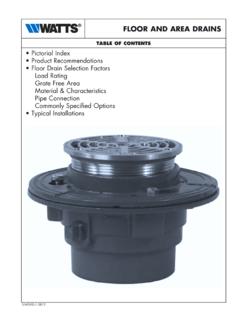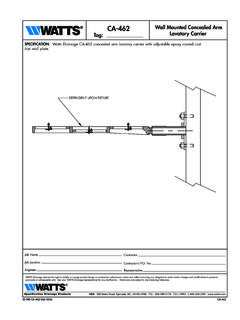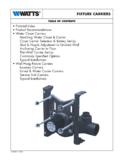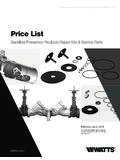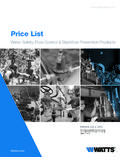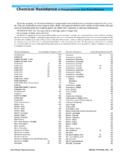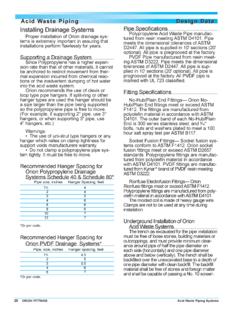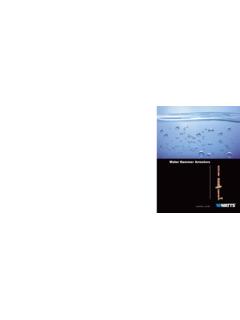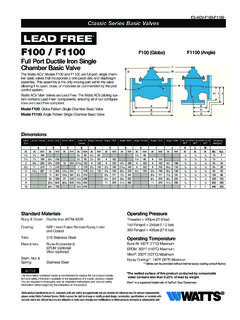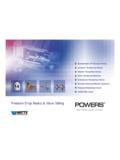Transcription of RP/IS-009 Installation, Maintenance, & Repair Series 009 ...
1 Installation, Maintenance, & Repair Series 009 and LF009 Reduced Pressure Zone AssembliesSizes: 1 4" 3" (8 80mm)RP/IS-0093" (80mm) 009 NRS TestingFor field testing procedure, refer to Watts installation sheets IS-TK-DP/DL, IS-TK-9A, IS-TK-99E and IS-TK-99D found on other Repair kits and service parts, refer to our Backflow Prevention Products Repair Kits & Service Parts price list PL-RP-BPD found on technical assistance, contact your local Watts Australia and New Zealand, line strainers should be installed between the upstream shutoff valve and the inlet of the backflow building or plumbing codes may require modifications to the information provided. You are required to consult the local building and plumbing codes prior to installation. If this informa-tion is not consistent with local building or plumbing codes, the local codes should be for Periodic Inspection/Maintenance: This product must be tested periodically in compliance with local codes, but at least once per year or more as service conditions installed on a fire suppression system, all mechanical checks, such as alarms and backflow preventers, should be flow tested and inspected in accordance with NFPA 13 and/or NFPA water conditions, and/or unauthorized adjustments or Repair could render the product ineffective for the service intended.
2 Regular checking and cleaning of the product s internal components helps assure maximum life and proper product !Read this Manual BEFORE using this to read and follow all safety and use information can result in death, serious personal injury, property damage, or damage to the this Manual for future InstructionsSeries 009 and LF009 Indoors Figure 1 For indoor installations, it is important that the assembly be easily accessible to facilitate testing and servicing. If it is lo cat ed in a line close to a wall, be sure the test cocks are easily accessible. A drain line and air gap (see literature ES-AG/EL/TC) should be piped from the relief valve connection as shown, where evidence of discharge will be clearly visible and so that water dam age will not occur. Therefore, never install in concealed 1 Air GapMainStrainerMeter21 2" 3" (65-80mm) 00912"NOTICEIn an area where freezing conditions can occur, Series 009 and LF009 should be installed above ground in an insulated 009 and LF009 must be installed in an ac ces si ble location to facilitate testing and ser vic ing.
3 A discharge line should be piped from the air gap at the relief valve con nec tion making sure that there is adequate drainage. Never pipe the discharge line directly into a drainage ditch, sewer or sump. Series 009 and LF009 should never be in stalled where any part of the unit could become submerged in standing water. Outside Figure 2In an area where freezing conditions do not occur, Series 009 and LF009 can be installed outside. The most sat is fac to ry in stal la tion is above ground and should be in stalled in this preventers should not be installed in pits unless approved by local codes. In such cases, a modified pit installation is available, WattsBox Insulated Enclosures, for more information, send for literature 2 WattsBox12"21 2" 3" (65-80mm) 009*Figure 3 Installation InstructionsSeries 009 and LF0092 NOTICES hutoff Valves: When shutoff valves are removed and re as sem-bly is necessary, the shutoff valve with the test cock is to be mount ed on the inlet side of the backflow preventer.
4 A. The 009 and LF009 should always be installed in an accessible location to facilitate testing and servicing (See page 2). Check the state and local codes to ensure that the backflow pre venter is installed in compliance, such as the proper height above the ground. B. We recommend a strainer be installed ahead of 009 and LF009 Series assemblies to protect the internal components from unnecessary fouling. CAUTION! Do not install with strainer when back flow preventer is used on seldom-used water lines which are called upon only during emergencies, such as fire sprinkler lines. Start Up: The down stream shutoff should be closed. Open upstream slowly and fill valve. When valve is filled, open the down-stream shutoff slowly and fill the water supply system. This is neces-sary to avoid water hammer or shock damage. C. Water discharge from the relief valve should be vented in ac cor-dance with code requirements.
5 The relief valve should never be solidly piped into a drainage ditch, sewer or sump. The discharge should be terminated approximately 12" above the ground or through an air gap piped to a floor drain. NOTICER elief Valve Discharge RatesThe installation of an air gap with the drain line terminating above a floor drain will handle any normal discharge or nuisance spit-ting through the relief valve. However, floor drain size may need to be designed to prevent water damage caused by a cat a-stroph ic failure condition. Please refer to Figure No. 4 for maxi-mum relief valve discharge rates, size and capacity of typical floor drains. Typical FlOw RaTEs as sizEd By floor dRain ManuFacTuRERs:2" (50 mm) 55 GPM5" (125 mm) 350 GPM3" (80 mm) 112 GPM6" (150 mm) 450 GPM4" (100 mm) 170 GPM8" (200 mm) 760 GPMP arallel Figure 3 Two or more smaller size assemblies can be piped in parallel (when approved) to serve a large supply pipe main.
6 This type of installation is employed where in creased capacity is needed beyond that provided by a single valve and permits testing or servicing of an individual valve without shutting down the complete number of assemblies used in par al lel should be determined by the en gi neer s judgment based on the operating con di tions of a specific parallel valve installations, the total capacity of the assemblies should equal or exceed that required by the inspection of all water system safety and control valves is required and necessary. Regular inspection, testing and cleaning assures maximum life and proper product not reduce the size of the drain line from the air gap fitting. Pipe full line After initial installation, a discharge from the relief valve opening may occur due to inadequate initial flushing of pipe lines to elimi-nate dirt and pipe compounds. If flush ing will not clear, remove the first check valve and clean thoroughly.
7 NOTICEP eriodic relief valve discharge may occur on dead end service applications, such as boiler feed lines or cooling tower makeup lines due to fluctuating supply pressure during a static or no flow condition. To avoid this discharge, install a spring-loaded rubber seated check valve ahead of the backflow assembly to lock-in the downstream pressure. E. Backflow preventers should never be placed in pits unless ab so-lute ly necessary and then only when and as approved by local codes. In such cases, provision should be made to always vent above flood level or for a pit drain to ensure an adequate air gap below the relief It is important that Series 009 and LF009 backflow preventers be inspected periodically for any discharge from the relief valve which will provide a visual indication of need for cleaning or Repair of check valves. Also testing for proper operation of the device should be made periodically in compliance with local codes, but at least once a year or more often, depending upon system con-ditions.
8 Relief vent will discharge water when, during no-flow periods, (1) the first check valve is fouled or (2) the inlet pressure to the device drops sufficiently due to upstream pressure fluctuations to affect the required operating differential between the inlet pres-sure and reduced pressure zone. Otherwise, such relief (spitting) can occur when the second check is fouled during emergency backflow or resulting from a water hammer condition. For Troubleshooting Guide send for S-TSG. NOTICES pecial considerations are necessary when testing as sem blies installed on Fire Prevention Systems. Fire Protection System Installations: The National Fire protec-tion Agency (NFPA) Guidelines require a confirming flow test be con duct ed whenever a main line valve such as the shutoff valves or a backflow assembly have been operated. Certified tes-ters of backflow assemblies must conduct this confirming test.
9 Figure 4 Relief Valve Discharge Rates1 2" 1" (15-25mm) 0094540353025201510500 10 20 30 40 50 60 70 80 90 100 150zone pressure psiFlow Rate gpm1 2"3 4" M21" M2X11 4" 3" (32-80mm) 0093503002502001501005000 10 20 30 40 50 60 70 80 90 100 150zone pressure psiFlow Rate gpm21 2" 3"2" M211 4" 11 2" M23 Servicing the Relief ValveSeries 009 and LF0091 4" 3" (8 80mm)1. Remove the four or six relief valve cover bolts while holding the cover down. 2. Lift the cover straight off. The stem and diaphragm assembly will normally remain with the cover as it is removed. The relief valve spring will be free inside the body at this point. 3. The relief valve seat is located at the bottom of the body bore, and can be removed, if necessary, for cleaning. The disc can be cleaned without disassembly of the relief valve module. If it is determined that the relief valve diaphragm and/or disc should be replaced, the relief valve module can be readily disassembled without the use of special tools.
10 NOTICE The disc rubber is molded into the disc holder and is supplied as a disc holder assembly. 4. To reassemble the relief valve, press the seat firmly into place in the body, center the spring on the seat, and insert the cover and relief valve module as a unit straight into the bore. Press down on the cover to assure proper alignment. Insert and tighten bolts. NOTICEIf cover will not press flat against body, stem assembly is crooked and damage can result. Realign stem and cover before bolts are inserted. NOTICE No special tools required to service Series 009 21/2" 3" (65 80mm).CoverCover O-ringDiaphragmStem & Diaphragm AssemblyRetainerSeatSeat O-ringBodyRelief Valve Service Parts KitTest Cock Cock Cock Check Module AssemblySecond Check Module AssemblyRelief Valve AssemblyWater OutletTest Cock No. 2 Test Cock No. 3 Test Cock No. 4 Ball Type Test CocksSecond Check Module ZoneWater OutletRelief Valve AssemblyFirst Check Module AssemblyCover O-ringDiaphragmStem AssemblyRetainerSeatSeat O-ringRelief Valve Service Parts KitSpringFlow Tube O-ring1.
